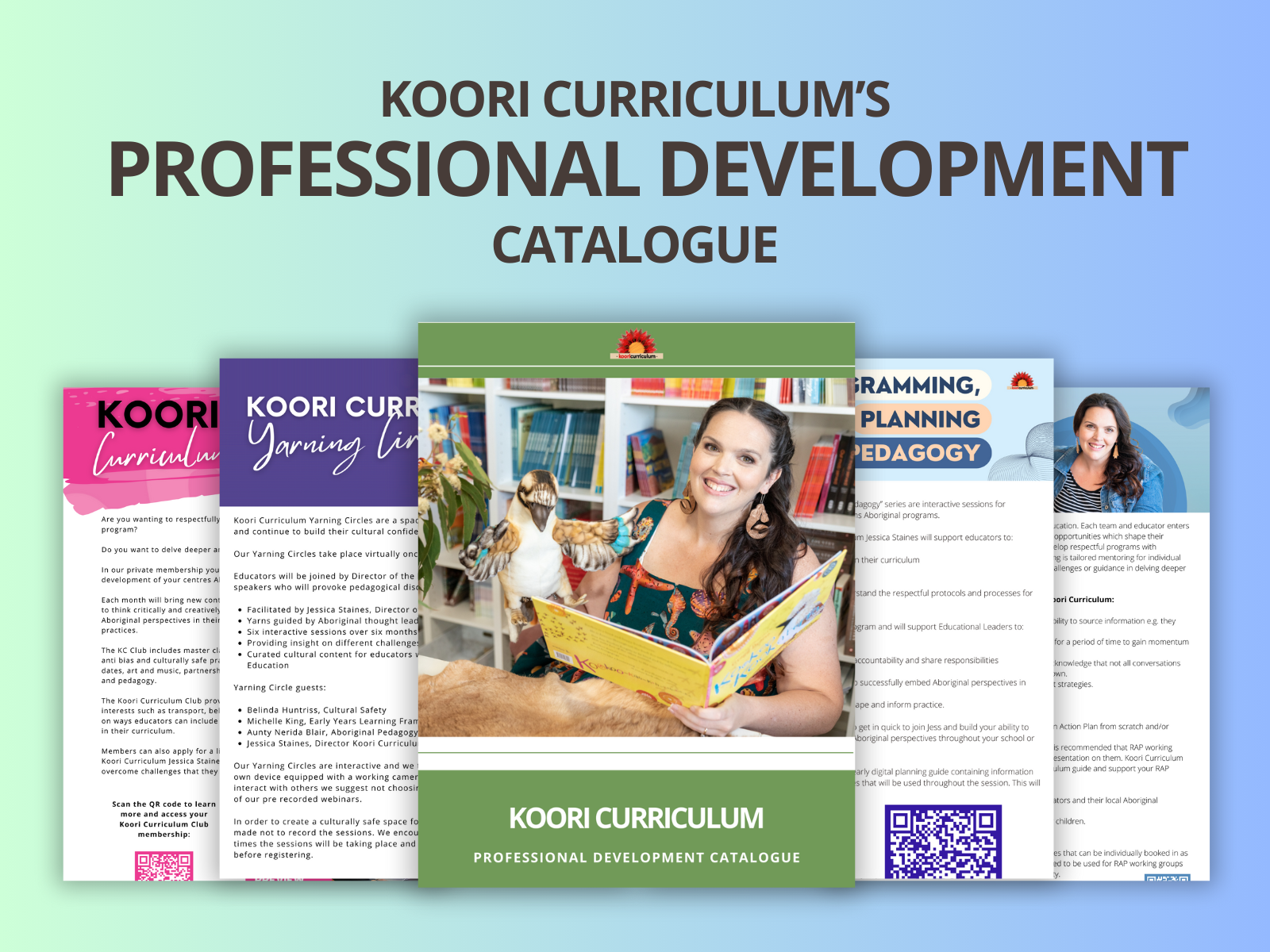
NAIDOC Art Competition Top 10 Submissions
WINNER!
Congratulations to
'Only About Children Seaforth'
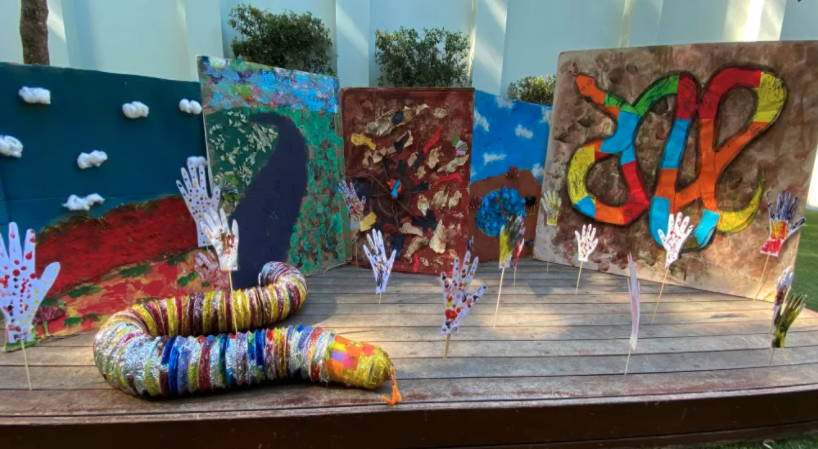
Always was, Always will be… The heart of Australia, the Aboriginal culture. An Art piece by the children of Only About Children Seaforth in a journey to discover more about the history of this land we call home. Our theme rides heavily on the Australian landscapes and animals which truly represent the essence of Australian. In our piece we focus on the importance of togetherness, respecting the land as it always was and always will be - a cultural landscape.
The children have all collaborated to further this theme of ‘togetherness’ through the making of great serpents, meeting places such as around the campfire and the waterhole with many animals gathering as well. The children joined their hands to create 100 hands, once again bringing in the theme of togetherness and unity.
We are one. One with the land. One with our culture and one with each other.
Our Finalists!
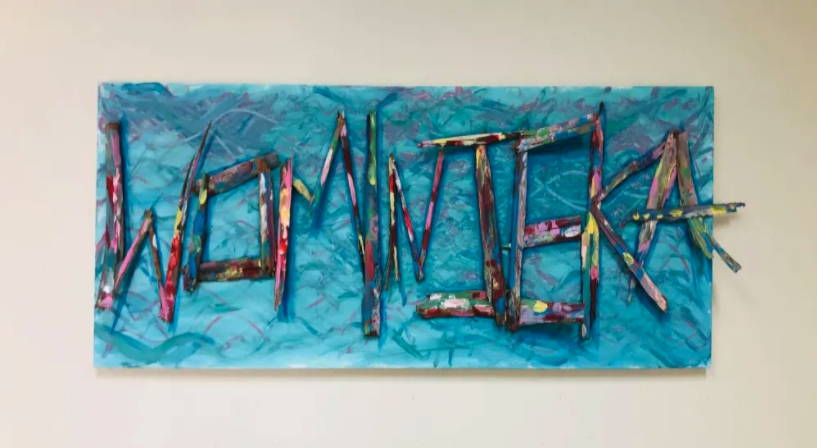
Our service is located on Boon Wurrung land, part of the Kulin Nation.
Our entry "Wominjeka' is an artistic piece using paints and bark on canvas that was created by children in our 2 year old group and 4 year old Kindergarten.Part of our Reconciliation Action Plan was to ensure the centre entrance was culturally welcoming. We decided to assist the children in creating a piece of work inspired by both our learning journey as educators, and the learning and creativity of the children that transpired as a result of our improved practice. Our centre team has been collectively been working on increasing and broadening our knowledge of Indigenous history. This new learning has then informed educator practice.
This submission is an example of how that learning journey has enriched educator practice and helped embed Aboriginal perspectives in the program.
The piece was created in two parts.
Part one - the bark painting: Educators embarked on a learning journey on how they could incorporate natural materials into their program and the cultural significance of these materials. One of these materials was bark. Educators researched tree bark painting and found that bark was painted and used for storytelling and instructional purposes. Our educators included in their teaching the children Bronwyn Bancrofts picture book 'Patterns of Australia'. Children then chose colours to paint the art that reflected different nature aspects around our service. They chose colours representing the water of the lake, the sky and that of the local flora and fauna.
Part 2 - the canvas painting: Educators sourced inspiration from local Aboriginal artists when looking at painting the canvas background of the bark art. We chose the beautiful artwork of Adam Mageniss, local Boon Wurrung artist, who specialises in landscapes. The children were shown one of his artworks, 'Stratigraphy of Country, Mornington Peninsula'. We then talked about what we thought each aspect of his artwork represented. This created a lot of discussion! The children then were given the choice of what part of their local landscape to represent on the canvas and they agreed on representing the local lake. They chose the colours accordingly and started their paint work. Educators then assisted the children with the hot glue gun to anchor their bark art. The finish product is now hanging in our foyer entrance and is a beautiful representation of learning, understanding and appreciation of the Aboriginal culture. We believe it to be culturally welcoming and something the children are all proud to talk to their families about when they arrive at the centre each day. Wominjeka!

During our Welcome/Acknowledgement to Country each morning throughout the year, the children of Yamba Preschool have excitedly shared with each other what aspect of country is special to them and what they care about, in particular animals and places. We listened to a Dreamtime story told by Miss Tiara's (a proud Yaegl woman) great grandfather Desmond Ferguson.
The story is about how the giant serpent created the different tribes in our area. It made its way through the ocean, up the river to the bottom of the mountains near Grafton. Every now and then it would shake off the barnacle creating each tribe. We made our representation of the serpent, starting at the ocean going through each area (ocean, river, the grasslands or sugar cane and mountains).
The children drew animals to place in their correct habitat. This Dreamtime story has tied together by the children’s love of animals and country and celebrates their understanding of Always Was, Always Will Be. The Giant Serpent Dreamtime story told by Desmond Ferguson continues to be copyrighted and cannot be reproduced in anyway other than what has been given approval/permission to do.
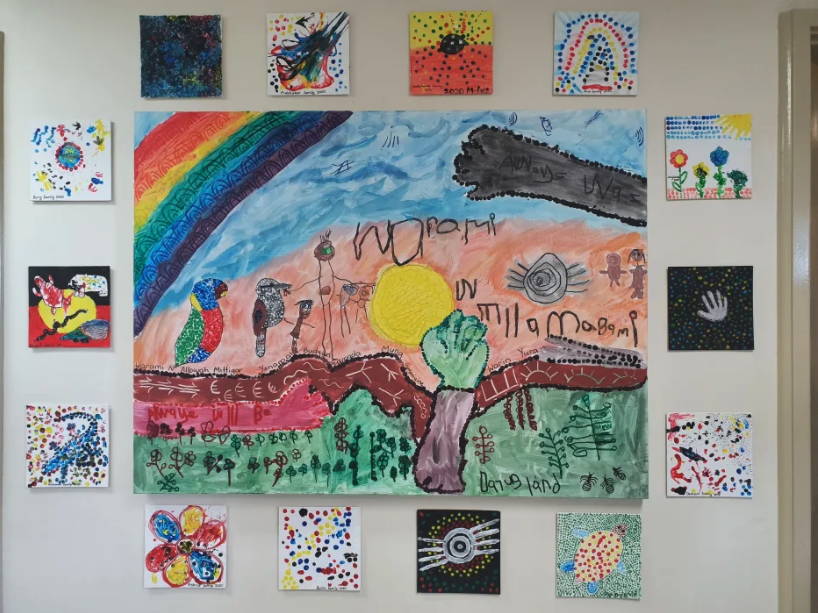
The idea of the competition was gifted to the children whom were extremely excited to partake, at the beginning of July. We began to discuss this years NAIDOC's week theme, always was, always will be and what it meant to our centre in small groups. Collaboratively the children came up with the notion, "we are on Darug land, it always was Darug land and it always will be Darug land", which became the foundation of their art piece, a landscape of the land of which our centre resides. The children reflected and discussed what they could see, small, hear and feel on Darug land which is depicted in their art; a rainbow, kookaburras, rainbow lorikeets, bush tucker, clouds, animals, people and a yarnging circle.
Whilst drafting their landscape the children decided they wanted to include the Aboriginal flag, and the words "always was, always will be, Darug land; and Warami Wellamabami". As the children continued upon their journey of creation, they discussed adding in Aboriginal symbols to represent various aspects of their outdoor environment; animal tracks, bush tucker, the sun, clouds, rainbow, ants. The children derived the idea of dot painting, the rainbow lorikeet and kookaburra from Gary Purchases artwork, which the children have been investigating and utilising as a provocation for quite some time now.
The tiles around the image were created by Kids Early Learning Blacktown City management and families from within our centre; each family was invited to take home a canvas tile and work together to create an art piece representative of this years NAIDOC theme, always was always will be and what that means to them.
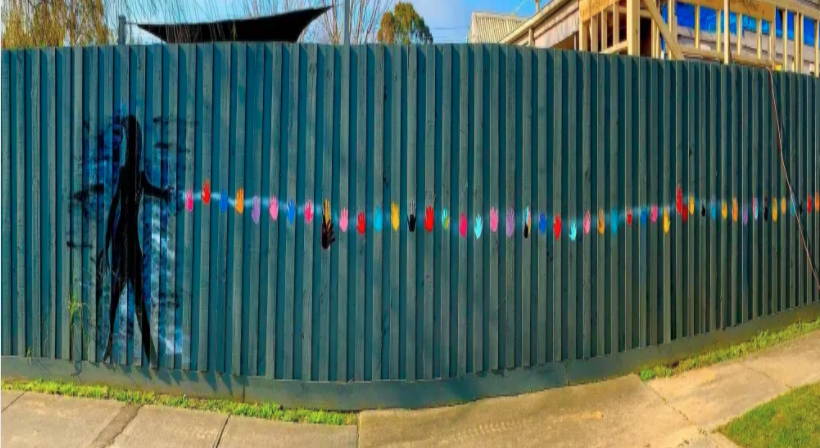
Submitted by Tyabb Village children's centre
This piece was created in collaboration with Artist Kath Flanagan - Gunditjmara, Kirrae - Whurrong woman, the children and the educators of Tyabb village children's centre. The brief was to take a negative and create something positive. Not long after the side fence (facing the road) had been freshly painted charcoal grey we arrived one morning to find a long white "tag" line almost the entire way along the centre of the fence. This was so disappointing, and no one wanted to paint the fence again. After some time and thought the service leader (Lavinia) sat across the road and looked long and hard at the line, pondering on what it could become and wondering how we could show the community our creativity.
After a few discussions with the children, inviting their ideas and seeking some guidance from the educators and our artist Kath Flanagan, we decided the tag line looked like a long rope and the children thought they could put their hands along it, and so began the first stage of our creation. Each child was excited to choose their colour and make their mark holding onto the rope.
When that stage was almost complete we talked again and decided that we should have an educator holding onto the rope leading the children back to "the village" after they had been out on a walk in the community or to the park or oval for fun and games. We used Educator Nicole to stand against the fence and we drew her outline holding the rope. It was important to the children that we included her baby bump and to represent the creation of life. Together we painted her into the picture, to look like a shadow.
The final stage to the artistic piece was added by Kath Flanagan. Kath worked with the children over a few weeks, finishing more hand prints along the rope. Kath has her Elders permission to use dots in her art (her traditional art form is hashing), she carefully dotted the outside of each child's hand with the colours they asked for. Kath also added the finishing touches to our shadow girl, making it look like she was in motion and that the wind was blowing past her as she walked the children back to the village base. Every time the children come and go from childcare or return from a community outing they will stop to find their hand or one that fits their hand. There is always so much joy as they do this, finding their sense of belonging to the village community.
It is clear the brief, negative to positive was achieved. We hope you like the beauty and connection in it. Thank you for accepting our submission Lavinia and the children from Tyabb Village children's centre
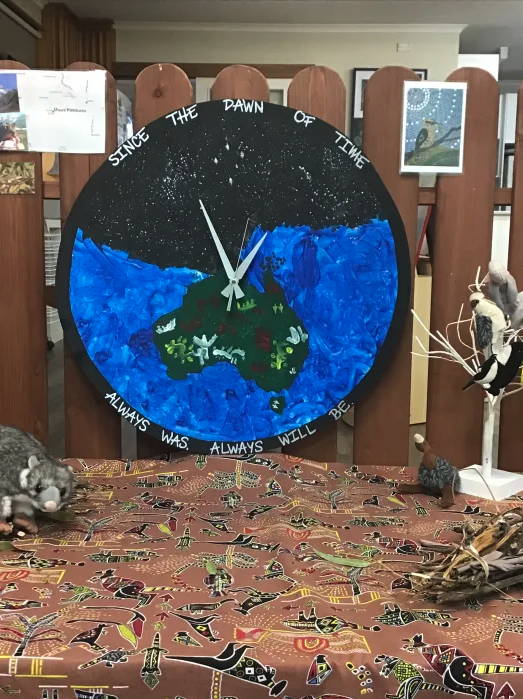
Cooma North Preschool which is on Ngarigo Land, had a FANTASTIC time collaborating and creating this artwork. When discussing with the children the 2020 NAIDOC Theme - Always was, Always will be - the children kept returning to the concept of time and that ‘always’ meant forever and all the time. That Australia’s first culture will ‘forever’ and ‘all the time’ be our first culture!!!
This lead to many discussions on the many ways of telling time, how we tell time now and how Aboriginal and Torres Strait Islanders use the stars, moon, sky and weather to measure the concept of time. So together, we came up with the idea to create a clock which is a circle that has no end, to show the cycle of time. The children wanted the land of Australia and the Torres Strait Islands to feature, with some indigenous animal prints on the land, as well as the stars to show how the Aboriginal people use the stars and sky to understand the seasons.
In the stars which the children added by tapping white paint off a brush, the Educators added the Southern Cross- a reference for Aboriginal and Torres Strait Islanders using the sky and the stars for telling time and stories.
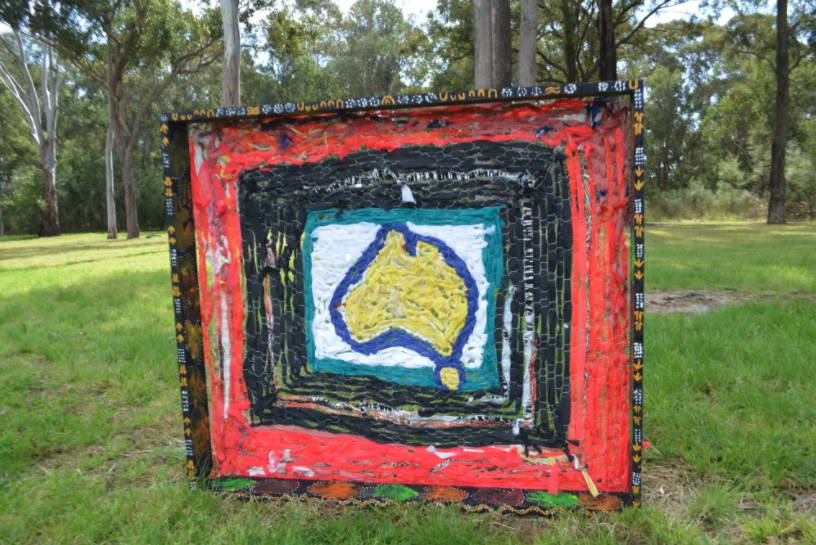
The Fabric Of Life The Children and Educators Of Western Sydney University Early Learning Bankstown have been working together to create an Art work that aims to reflect the NAIDOC theme for 2020 ‘Always Was Always Will Be’.
Through song,dance,stories group time yarnings and creative activities, our children really embrace learning about Australia’s Aboriginal and Torres Strait Islander Peoples. They are particularly intrigued by the Indigenous Flags and can proudly share what the colours represent. Therefore the children’s connection to the flags determined the colours and design our Art work would take.
Weaving became the chosen medium because it was something all ages could contribute to. We also hope that the actual process of weaving pays respect to the Indigenous weaving of the past and present. On a profound level it is our wish that it will help us all understand how we are all woven together as fellow human beings. To achieve this, the textual effects were created by using fabric donated by our families. It was woven on to a frame made by the partner of one of our staff members, thus including many members of our community.
It is our hope that our weaving pays tribute to the wisdom, strength and determination of our Nation’s first People. We offer our appreciation for the love and care of our Country shown by the true custodians of our land. ‘Always Was Always Will Be’.
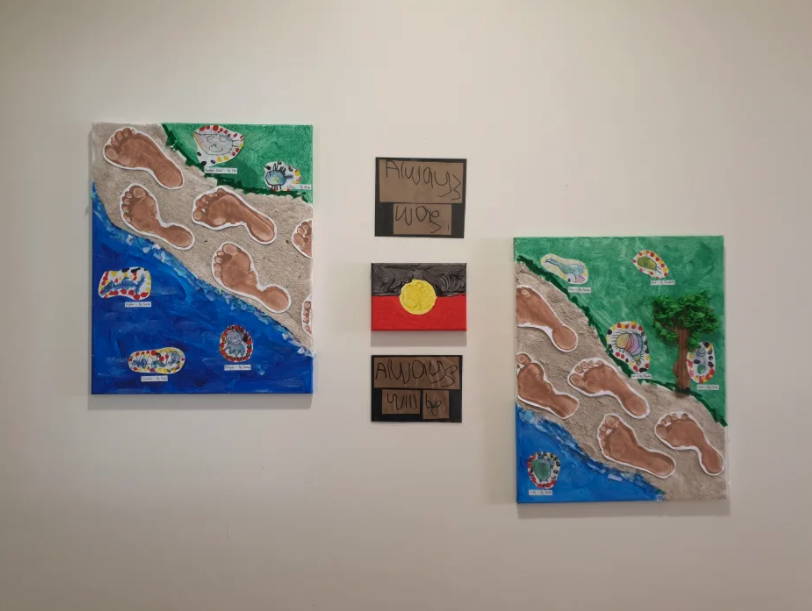
This collaborative art piece was created and designed by our Preschool children at Goodstart Ballina and is displayed in our hallway for all our families to enjoy. We would like to acknowledge the Nyangbul Clan of the Bundjalung Nation for sharing their beautiful coastal lands with us.
At Goodstart Ballina we promise to show care and respect for the land, animals and the people too, and acknowledge every day that Aboriginal and Torres Strait Islander People are our First Nations Peoples. Our creative collaboration explores Ballina’s close relationship to the land and sea. The children’s interest was in the animals that live in these areas. They identified the animals that we coexist with in these spaces and created their own representations of these while referencing ‘ABC Dreaming’ by Warren Brim. We had many discussions on how the land we live, work and play on was not ours to begin with and how important it is that we are custodians of this beautiful land we share. We talked about how, just like footprints in the sand things can easily disappear over time but it’s important for us to remember and share for future generations as represented in “Always was, always will be”, which one of our Preschool children wrote so beautifully for us to share with you. All of our 29 students had a hand in creating this beautiful display over a 2 week period.
We hope you like our art work as much as we do and thank you for giving us the opportunity to share it with so many.
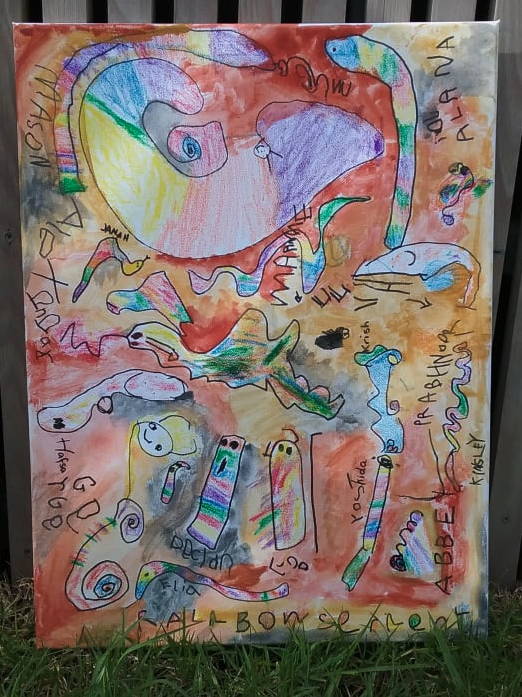
Our artwork titled 'Rainbow Serpent' is a collaborative artwork piece designed by preschool children at Aitken Hill Preschool. We have seven indigenous children attending our service in 2020 across 6 groups of 33 children. Indigenous culture is a large part of our daily program and practice. We read the Dream time Story 'The Rainbow Serpent' to all of our preschool children. We held discussions about the creation of rivers, creeks and mountains. to further extend our learning about indigenous culture.
The children have drawn their own interpretations and understandings about the 'Rainbow Serpent'. The children have painted their thoughts and ideas using fine brushes and earth toned water colours to represent the ochre colours of the land on which the play. We will display the artwork in our preschool foyer area of our Community Centre. We are so proud and hope you like it too.
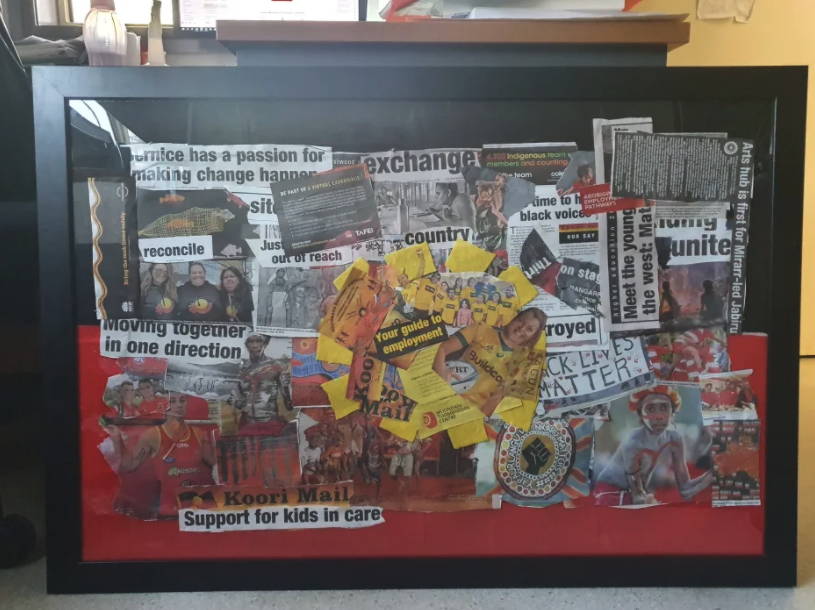
The children have been encouraged to engage with indigenous texts and prints in the classroom, and when the challenge was proposed the children spent some time looking through our collected Koori mail newspapers and news clippings. The children were able to cut or rip out whatever they wanted, and educators had discussions around the content of their choices and the paper they were interacting with.
Each room had a colour to look out for in their newspapers; reflecting the colours of the Aboriginal flag.
Through this experience the children showed interest in the people they saw inside the newspaper, and many wanted to cut out traditional photos, costumed indigenous dancers and more.
The children were exposed to an array of new discussions around Aboriginal voices and cultures.


